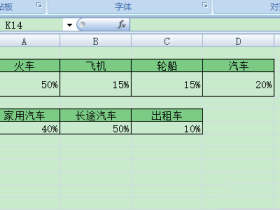- A+
这篇文章主要给大家介绍了利用Python实现斐波那契数列的几种方法,文中通过示例代码介绍的非常详细,对大家的学习或者使用Python具有一定的参考学习价值,需要的朋友们下面来一起学习学习吧
斐波那契数列——经典例子,永不过时!!!
1.for循环
1 2 3 4 5 6 7 8 | def fibonacci1(n): a, b = 0, 1 for i in range(n): a, b = b, a+b print(a)fibonacci1(3) |
或
1 2 3 4 5 6 7 | def fib1(w): a, b = 1, 1 for i in range(w-1): a, b = b, a+b return aprint(fib1(3)) |
[^1]刚好得出这个位置的数
2.while循环
1 2 3 4 5 6 7 8 9 | def fibnaqi2(m): a, b = 0, 1 i = 0 while i < m: print(b) a, b = b, a+b i += 1fibnaqi2(4) |
[^1]刚好得出这个位置的数
3.使用递归
1 2 3 4 5 6 | def fib2(q): if q == 1 or q == 2: return 1 return fib2(q-1)+fib2(q-2)print(fib2(9)) |
4.递归+for循环
1 2 3 4 5 6 7 8 9 10 | def fibnacci3(p): lst = [] for i in range(p): if i == 1 or i == 0: lst.append(1) else: lst.append(lst[i-1]+lst[i-2]) print(lst)fibnacci3(5) |
5.递归+while循环
1 2 3 4 5 6 7 8 9 10 11 12 | def fibnacci4(k): lis = [] i = 0 while i<k: if i == 0 or i == 1: lis.append(1) else: lis.append(lis[i-2]+lis[i-1]) i += 1 print(lis)fibnacci4(6) |
6.递归+定义函数+for循环
1 2 3 4 5 6 7 8 9 10 | def fibnacci5(o): def fn(i): if i < 2: return 1 else: return (fn(i-2)+fn(i-1)) for i in range(o): print(fn(i))fibnacci5(8) |
7.指定列表
1 2 3 4 5 6 7 8 9 10 11 | def fib3(e): if e == 1: return [1] if e == 2: return [1, 1] fibs = [1, 1] for i in range(2, e): fibs.append(fibs[-1]+fibs[-2]) return fibsprint(fib3(12)) |
趣方程求解
题目描述
二次方程式 ax**2 + bx + c = 0 (a、b、c 用户提供,为实数,a ≠ 0)
1 2 3 4 5 6 7 8 9 10 11 12 13 14 15 | # 导入 cmath(复杂数学运算) 模块import cmatha = float(input('输入 a: '))b = float(input('输入 b: '))c = float(input('输入 c: '))# 计算d = (b ** 2) - (4 * a * c)# 两种求解方式sol1 = (-b - cmath.sqrt(d)) / (2 * a)sol2 = (-b + cmath.sqrt(d)) / (2 * a)print('结果为 {0} 和 {1}'.format(sol1, sol2)) |
pandas 每日一练
1 2 3 4 5 6 7 8 9 10 11 12 13 | # -*- coding = utf-8 -*-# @Time : 2022/7/26 21:48# @Author : lxw_pro# @File : pandas -8 练习.py# @Software : PyCharmimport pandas as pdimport numpy as npdf = pd.read_excel('text5.xlsx')print(df)print() |
程序运行结果如下:
Unnamed: 0 Unnamed: 0.1 project ... test_time date time
0 0 00:00:00 Python ... 2022-06-20 18:30:20 2022-06-20 18:30:20
1 1 1 Java ... 2022-06-18 19:40:20 2022-06-18 19:40:20
2 2 2 C ... 2022-06-08 13:33:20 2022-06-08 13:33:20
3 3 3 MySQL ... 2021-12-23 11:26:20 2021-12-23 11:26:20
4 4 4 Linux ... 2021-12-20 18:20:20 2021-12-20 18:20:20
5 5 5 Math ... 2022-07-20 16:30:20 2022-07-20 16:30:20
6 6 6 English ... 2022-06-23 15:30:20 2022-06-23 15:30:20
7 7 7 Python ... 2022-07-19 09:30:20 2022-07-19 09:30:20
[8 rows x 7 columns]
41、将test_time列设置为索引
1 2 3 | print(df.set_index('test_time'))print() |
程序运行结果如下:
Unnamed: 0 Unnamed: 0.1 ... date time
test_time ...
2022-06-20 18:30:20 0 00:00:00 ... 2022-06-20 18:30:20
2022-06-18 19:40:20 1 1 ... 2022-06-18 19:40:20
2022-06-08 13:33:20 2 2 ... 2022-06-08 13:33:20
2021-12-23 11:26:20 3 3 ... 2021-12-23 11:26:20
2021-12-20 18:20:20 4 4 ... 2021-12-20 18:20:20
2022-07-20 16:30:20 5 5 ... 2022-07-20 16:30:20
2022-06-23 15:30:20 6 6 ... 2022-06-23 15:30:20
2022-07-19 09:30:20 7 7 ... 2022-07-19 09:30:20
[8 rows x 6 columns]
42、生成一个和df长度相同的随机数dataframe
1 2 3 4 | df1 = pd.DataFrame(pd.Series(np.random.randint(1, 10, 8)))print(df1)print() |
程序运行结果如下:
0
0 1
1 3
2 2
3 7
4 7
5 3
6 5
7 1
43、将上一题生成的dataframe与df合并
1 2 3 4 | df = pd.concat([df, df1], axis=1)print(df)print() |
程序运行结果如下:
Unnamed: 0 Unnamed: 0.1 project ... date time 0
0 0 00:00:00 Python ... 2022-06-20 18:30:20 1
1 1 1 Java ... 2022-06-18 19:40:20 3
2 2 2 C ... 2022-06-08 13:33:20 2
3 3 3 MySQL ... 2021-12-23 11:26:20 7
4 4 4 Linux ... 2021-12-20 18:20:20 7
5 5 5 Math ... 2022-07-20 16:30:20 3
6 6 6 English ... 2022-06-23 15:30:20 5
7 7 7 Python ... 2022-07-19 09:30:20 1
[8 rows x 8 columns]
44、生成新的一列new为popularity列减去之前生成随机数列
1 2 3 4 | df['new'] = df['popularity'] - df[0]print(df)print() |
程序运行结果如下:
Unnamed: 0 Unnamed: 0.1 project popularity ... date time 0 new
0 0 00:00:00 Python 95 ... 2022-06-20 18:30:20 1 94
1 1 1 Java 92 ... 2022-06-18 19:40:20 3 89
2 2 2 C 145 ... 2022-06-08 13:33:20 2 143
3 3 3 MySQL 141 ... 2021-12-23 11:26:20 7 134
4 4 4 Linux 84 ... 2021-12-20 18:20:20 7 77
5 5 5 Math 148 ... 2022-07-20 16:30:20 3 145
6 6 6 English 146 ... 2022-06-23 15:30:20 5 141
7 7 7 Python 149 ... 2022-07-19 09:30:20 1 148
[8 rows x 9 columns]
45、检查数据中是否含有任何缺失值
1 2 3 4 | jch = df.isnull().values.any()print(jch) # 运行结果为:Falseprint() |
46、将popularity列类型转换为浮点数
1 2 3 4 | fds = df['popularity'].astype(np.float64)print(fds)print() |
程序运行结果如下:
0 95.0
1 92.0
2 145.0
3 141.0
4 84.0
5 148.0
6 146.0
7 149.0
Name: popularity, dtype: float64
47、计算popularity大于100的次数
1 2 3 4 | cs = len(df[df['popularity'] > 100])print(cs) # 运行结果为:5print() |
48、查看project列共有几种学历
1 2 3 4 | ckj = df['project'].nunique()print(ckj) # 运行结果为:7print() |
49、查看每科出现的次数
1 2 3 4 | ckc = df.project.value_counts()print(ckc)print() |
程序运行结果如下:
Python 2
Java 1
C 1
MySQL 1
Linux 1
Math 1
English 1
Name: project, dtype: int64
50、提取popularity与new列的和大于136的最后3行
1 2 3 4 | df1 = df[['popularity', 'new']]hh = df1.apply(np.sum, axis=1)res = df.iloc[np.where(hh > 136)[0][-3:], :]print(res) |
程序运行结果如下:
Unnamed: 0 Unnamed: 0.1 project popularity ... date time 0 new
5 5 5 Math 148 ... 2022-07-20 16:30:20 3 145
6 6 6 English 146 ... 2022-06-23 15:30:20 5 141
7 7 7 Python 149 ... 2022-07-19 09:30:20 1 148
[3 rows x 9 columns]
到此这篇关于Python实现斐波那契数列的多种写法总结的文章就介绍到这了
大家都在看:
- 我的微信
- 这是我的微信扫一扫
-

- 设计福利助手
- 我的微信公众号扫一扫
-




